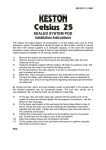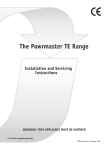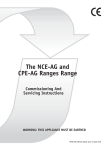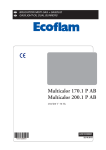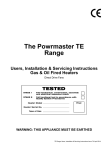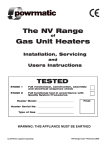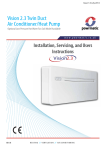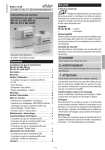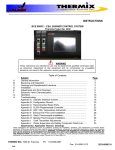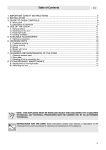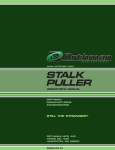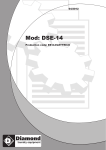Download DHM Service Manual
Transcript
CE DHM Range Commissioning And Servicing Instructions WARNING: THIS APPLIANCE MUST BE EARTHED DHM Range C & S Issue 6 September 2002 1. INTRODUCTION The Powrmatic DHM range are multiple tube heating modules designed for insertion into duct heaters, air conditioning plant and similar units. Each module comprises a number of gas fired forced draught burners and a single exhaust gas fan venting into a closed flue system. Each burner/tube assembly in a module is rated at 40 kW, 20kW, 15kW or 10kW output. DHM X/20 units are certified for use on Natural Gas, Group H - G20 and Propane - G31 and are Cat II2H3P. (Note: Conversion from one gas to another is factory completed.) DHM X/10, DHM X/15 and DHM X/40 units are certified for use only on Natural Gas, Group H - G20 and are Cat I2H. 2. Technical Data 2.1 Dimensions 2740 DHM40, 2280 DHM15/20, 1630 DHM10 325 DHM10/15/20 650 DHM40 2300 DHM40, 1800 DHM15/20, 1160 DHM10 BURNER ASSEMBLY See below REAR FRONT HEADER TUBES GAS MANIFOLD Gas connection size R1 BURNER END EXHAUST FAN ASSEMBLY DHM 5/xx MODULE SHOWN EXHAUST MANIFOLD PLAN Notes: 1 Low fire is with only one of the five burner modules running. 2 Maximum Ambient Temperature - 25°C 3 Maximum Gas Inlet Pressure - 60mbar Module 3/xx 4/xx 5/xx 6/xx 7/xx Height 910 1155 1400 1645 1890 2.2 Performance Data 3/10 4/10 5/10 6/10 7/10 3/15 4/15 5/15 6/15 7/15 Heat Input (Max) kW 33.3 44.4 55.5 66.6 77.7 48.9 65.2 81.5 97.8 114.1 Heat Output (Max) kW 30.0 40.0 50.0 60.0 70.0 45.0 60.0 75.0 90.0 105.0 Heat Input (Min) kW 11.1 16.3 Heat Output (Min) kW 10.0 15.0 Power Input kW 0.11 0.11 Start Current Amps 0.63 0.63 Run Current Amps m3/s 0.5 0.48 0.86 1.14 1.43 1.72 2.0 1.215 1.62 2.025 2.43 2.83 kg 64 85 106 128 150 98 131 164 197 230 Min air flow rate Weight 1 3/20 4/20 5/20 6/20 7/20 3/40 4/40 5/40 6/40 7/40 Heat Input (Max) kW 66.0 88.0 110.0 132.0 154.0 131.8 175.8 219.8 263.7 307.7 Heat Output (Max) kW 60.0 80.0 100.0 120.0 140.0 120.0 160.0 200.0 240.0 280.0 Heat Input (Min) kW 22.0 44.0 Heat Output (Min) kW 20.0 38.0 Power Input kW 0.21 0.6 Start Current Amps 2.8 10.0 Run Current Amps m3/s 0.9 4.0 1.62 2.16 2.7 3.24 3.78 3.24 4.32 5.4 6.48 7.56 kg 98 131 164 197 230 196 262 328 394 460 Min air flow rate Weight 2.3 Gas Controls Schematic 1st Main Gas Safety Shut-off Valve Fig 1 2nd Main Gas Safety Shut-off Valve Pressure Test Point To Burner Main Gas Governor 1st Main Gas Safety Shut-off Valve 2nd Main Gas Safety Shut-off Valve Pressure Test Point To Burner Main Gas Governor 1st Main Gas Safety Shut-off Valve 2nd Main Gas Safety Shut-off Valve Pressure Test Point To Burner Main Gas Governor 1st Main Gas Safety Shut-off Valve 2nd Main Gas Safety Shut-off Valve Pressure Test Point To Burner Main Gas Governor 1st Main Gas Safety Shut-off Valve 2nd Main Gas Safety Shut-off Valve Pressure Test Point Gas Inlet Pressure Test Point To Burner DHM 5/xx MODULE SHOWN Main Gas Governor 2 Table 1 Injector Sizes & Burner Pressure Natural Gas - Group H - G20 Net CV (Hi) = 34.02MJ/m³ 3/10 4/10 5/10 6/10 7/10 3/15 4/15 5/15 6/15 7/15 3.52 4.69 5.87 7.07 8.22 5.17 6.89 8.62 10.33 12.06 Gas Rate (Max) m³/h Burner Pressure mbar 12.0 at each burner 10.0 at each burner Injector size mm 2.8 3.59 Gas Rate (Max) m³/h Burner Pressure mbar Injector size mm 3/20 4/20 5/20 6/20 7/20 3/40 4/40 5/40 6/40 7/40 6.98 9.3 11.63 13.96 16.28 13.96 18.6 23.26 27.92 32.56 10.6 at each burner 10.0 at each burner 4.1 Table 2 Injector Sizes & Burner Pressure Propane -G31 Net CV (Hi) = 88.00MJ/m³ 3/20 4/20 5/20 6/20 7/20 2.70 3.60 4.50 5.40 6.30 Gas Rate (Max) m³/h Burner Pressure mbar 24.0 at each burner Injector size mm 2.6 rate of less than 0.5/h, and in heated spaces having a volume less than 4.7 m3 /kW of total rated heat input, grilles shall be provided at low level as follows:The total minimum free area shall not be less than 270cm2 plus 2.25 cm2 per kilowatt in excess of 60 kW rated heat input. The air vent(s) should have negligible resistance and must not be sited in any position where it is likely to be easily blocked or flooded or in any position adjacent to an extraction system which is carrying flammable vapour. 3. General Requirements 3.1 Related Documents The installation of the module must be in accordance with the rules in force and the relevant requirements of the Gas Safety Regulations and the I.E.E. Regulations for Electrical Installations. 3.2 Electrical Supply The module requires 230V - 1ph, 50Hz fused at 5A. The method of connection to the main electricity supply must facilitate the complete electrical isolation of the module. The isolator must have a contact separation of at least 3mm in all poles. See the accompanying wiring diagram for the module electrical connections. Where the duct heater or air handling unit is to be installed in a plant room there must be permanent air vents communicating directly with the outside air, at high level and at low level. Where communication with the outside air is possible only by means of high level air vents, ducting down to floor level for the lower vents should be used. Air vents should have negligible resistance and must not be sited in any position where they are likely to be easily blocked or flooded or in any position adjacent to an extraction system which is carrying flammable vapour. Grilles or louvres should be so designed that high velocity air streams do not occur within the plant room. 3.3 Gas Connection A servicing valve and downstream union must be fitted at the inlet to the module gas controls assembly to facilitate servicing. The gas supply to the module must be completed in solid pipework and be adequately supported. Warning: When completing the final gas connection to the module do not place undue strain on the gas pipework of the module. 3.4 Combustion Air Supply If the duct heater or air handling unit is installed internally in buildings having a design air change The basic minimum effective area requirements of the air vents are as follows: 3 (a) Low Level (inlet) For heaters of total rated heat input 60 kW or more: 540 cm2 plus 4.5 cm2 per kilowatt in excess of 60kW total rated input. (b) High Level (outlet) For heaters of total rated heat input 60 kW or more: 270 cm2 plus 2.25 cm2 per kilowatt in excess of 60kW total rated input. 4.3.3 Final Adjustment 1. Remove the sealing screw from the pressure test point located on the gas valve of the first burner and attach a pressure gauge. Remove the sample point cover plug from the outlet flue length and insert a CO2 measuring instrument. 2. Turn "ON" the main electricity supply via the duct heater/air handler controlsand check that the following sequence of events occur. i) Exhaust fan runs. ii) Ignition spark is heard iii) Main gas valves open iv) Main gas flame is established. 3. Check that the burner gas pressure agrees with that in Section 2. If necessary adjust the burner gas pressure by turning the adjustment screw on the side of the valve. See Fig 2 5. Turn "OFF" the main electricity supply, remove pressure gauge and refit sealing screw in pressure test point. 6. Repeat for the remaining burners in the module. 7. With all burners running check the CO2 content of the flue gases which should be in the range of 7.5 - 8.5%. 7. Turn "OFF" the main electricity supply and refit flue sample point cover plug. 4. Commissioning & Testing Gas Safety (Installation & Use) Regulations 1994 It is law that all gas appliances are installed, adjusted and, if necessary, converted by qualified persons* in accordance with the above regulations. Failure to install appliances correctly can lead to prosecution. It is in your own interests and that of safety to ensure that the law is complied with. * e.g. Corgi Registered 4.1 Electrical Installation Checks to ensure electrical safety must be carried out by a competent person. 4.2 Gas Installation The whole of the gas installation, including the meter, should be inspected and tested for soundness and purged in accordance with the recommendations of IM/16:1988. 4.4 Final Soundness Test 1. After making final gas rate checks all joints on the gas controls assembly must be tested for soundness using leak detection fluid. 4.3 Lighting the Module 4.3.1 Gas Controls Assembly - Soundness Check 1. Ensure the gas service valve at the inlet to the gas controls assembly is shut. 2. To prove soundness up to the first main safety shut-off valve of each burner:a) Connect pressure gauge to the inlet pressure test point on the gas manifold. b) Open gas service valve and allow pressure to stabilise before shutting it again. The valves are sound if no pressure drop is observerved. If a pressure drop is observed do not proceed until the fault has been rectified. Remove pressure gauge and refit sealing screw in pressure test point. 4.5 Flame Safeguard 1. Whilst the burner is in operation close the gas service valve. The burners should go to lockout within 1 second. 4.6 User Instructions The Users instruction supplied with the module are for the end customer and must be supplied with the module. 5. Servicing The DHM unit should be serviced once per year. 4.3.2 Sequence Check 1. Ensure that the gas service valve is closed and that the main electrical supply to the module is switched off. 2. Check that all external controls are calling for heat. 3. Turn "ON" the main electrical supply and check that the following sequence of events occurs. i) Exhaust fan runs Then for each module:i) Ignition spark is heard ii) Main gas valves open. iii)Burner goes to lockout as there is no gas supply. Reset from lockout 4. Switch off main electricity supply. WARNING: Always switch off and isolate the incoming electrical supply and close the gas service valve before carrying out any servicing work. 5.1 General Full maintainance should be undertaken not less than once per year. After any service work has been completed, or any component replaced the unit should be recommissioned as detailed in Section 4. 5.2 Burners 1. Remove the heat shield (if fitted) situated between the exhaust fan and burners/contols section. 4 Fig 2 Burner Assembly Rectification electrode Pressure switch impulse pipe Reverse side of Gas Valve Ignition electrode Pressure Switch Governor adjustment screw Earth electrode Full Sequence Control Burner Body Injector 3.5 - 4.5mm Cup Burner Front view of electrode assembly Swirler Gas Valve Gas Inlet Burner Assembly 2. Release the single securing screw retaining the full sequence control to the gas valve assembly and pull off the full sequence control. 3. Pull off the electrical leads to the pressure switch on the burner concerned. 4. Remove the screws securing the gas inlet flange to the gas manifold. 5. Pull the burner out from the primary tube and clear of the gas manifold. 6. Check that the electrodes and swirler plate are in good condition. Replace if necessary. 7. Check that the primary tube is clear internally. 9. Access is available, if required, to the outlet end of the secondary tube. Remove the cover plates at the right hand side of the bulkhead and then remove the appropriate access plate from the internal manifold. 8. Reassemble burner in reverse order and a new cork gasket on the manifold flange. 9. Repeat for the remaing burners in the module. 10. Replace heat shield (if fitted). 7. Inspect the fan blades and, if necessary, remove any deposit build up using a stiff brush. 8. Reassemble in reverse order. 5.4 Replacement of Faulty Components 5.4.1 Full Sequence Control 1. Remove the single screw retaining the control to the gas valve. 2. Remove the top of the contol and pull off the electrical connection plugs and the spark and rectification leads. 3. Remove the control from the gas valve by pulling upwards. 4. Refit replacement in reverse order. 5.4.2 Electrode Assembly 1. Release the screw retaining the top cover of the associated gas control. 2. Remove the top of the contol and pull off the spark and rectification leads. 3. Remove the screw on the front face of the electrode assembly and remove assembly. 4. Refit replacement in reverse order. 5.3 Exhaust Fan 1. Remove the heat shield (if fitted) situated between the exhaust fan and burners/contols section. 2. Remove electrical connections to the exhaust fan overrun thermostat situated on the fan casing. 3. Remove the electrical connections from the exhaust fan motor. 4. Remove the pressure switch impulse pipe. 5. Disconnect flue system from exhaust fan outlet. 6. Remove the four set screws securing the fan inlet tube to the fan and the two screws securing the fan support bracket to the bulk head. 5.4.3 Gas Control Valve/Burner/Injector 1. Complete steps 5.2.1 to 5.2.5 2. Remove the screws securing the pressure switch bracket to the gas valve 3. Seperate the burner end cap/injector holder from the body of the burner 4. Unscrew the cup burner and remove the burner end cap from the injector 5. Remove the injector from the gas valve 6. Remove the inlet pipe from the gas valve 7. Reassemble in reverse order using new items as required and a new cork gasket on the 5 Fig 3 Honeywell L4064N Limit Thermostat S Set Point Dial 6. Fault Finding Fault 100 120 Limit Circuit LI Fan Circuit 5.4.6 Exhaust Fan Pressure Switch 1. Remove the impulse pipe from the pressure switch 2. Remove the pressure switch cover and disconnect the wiring 3. Remove the screws securing the pressure switch mounting bracket to the controls panel 4. Remove the bracket from the pressure switch 5. Reassemble in reverse order using replacement pressure switch NOTE: Impulse pipe is connected to suction (-) tapping. Pressure switch set point is 2.0mb MI T 5.4.5 Exhaust Fan Overrun Thermostat 1. Pull off the electrical connections from the thermostat 2. Remove the two securing screws 3. Reassemble in reverse order using new thermostat. FA N 0 5.4.4 Exhaust Fan 1. Complete steps 5.3.1. to 5.3.7 2. Reassemble in reverse order using replacement fan. 5.4.7 Limit Thermostat 1. Remove the single screw securing the thermostat cover 2. Re move t he e le c t r i c a l c o n ne c t i o ns 3. Remove the screws securing the thermostat to the bulkhead and withdraw the thermostat 4. Reassemble in reverse order using replacement thermostat. NOTE: Only the limit circuit is used and the limit set point is 100°c. CA DIA DO N OT U T LW IO R HE N S O TA TE N ET - H TIN O G PO LD INT ER manifold flange. 8. Replace heat shield (if fitted). 20 8 40 60 Summer / Winter Switch Limit Reset Fan Circuit Limit Circuit Jumper Location Cause Action Exhaust fan does not run Electrical No spark ignition Electrical Burner will not light Electrical Exhaust fan runs continuously Electrical 1. Check that there is a main electrical supply present. 2. Check that all external control circuits are completed. 3. Check that high limit thermostat has not tripped reset. 4. Check that mains voltage is present at fan motor change fan if faulty. 1. Check full sequence is not at lockout - reset. 2. Check full sequence controls for mains supply change if necessary. 3. Check that exhaust fan and burner air pressure switches are activated. 4. Check spark electrode and spark gap. 1. Check rectification electrode/lead/signal. 2. Check gas supply is ON. 1. Check overrun thermostat. 7. Short List of Parts Refer to Powrmatic Ltd for the details of any parts not listed here. ITEM Gas Valve - SIT 830 Tandem 0833033 - 1/2"BSP. Full Sequence Control - SIT 503EFD Thermostat - Limit - Honeywell L4064N. Thermostat - Exhaust Fan -RS 331-540 Exhaust Fan - AD 90BWTLG90 (x/40 modules) Exhaust Fan - AD 71DTXL (x/20 modules) Exhaust Fan - AD 52BTXL (x/10 & x/15 modules) Pressure Switch - Kromschroder DL5K Pressure Switch - Honeywell C6065A1028:2 Electrode - Rectification - Johnston Controls Electrode - Ignition - Johnston Controls Relay - Finder 60128230 PART NUMBER 142400444 145601045 143000303 147600001 140201504 140201502 140210500 145604643 146522170 142400625 142400625 143000813 BSI Registered Firm FM 414 Ind. & Comm. Air Heaters; Air Moving Equipment; Flues & Chimneys; Natural Smoke & Heat Ventilators; Powered Supply & Extract Fans & Systems. HEATING DIVISION Winterhay Lane Ilminster, Somerset TA19 9PQ Tel: 01460 53535 Fax: 01460 52341 Every effort is made to ensure accuracy at time of going to press. However as part of our policy of continual product improvement, we reserve the right to alter specifications without prior notice.










